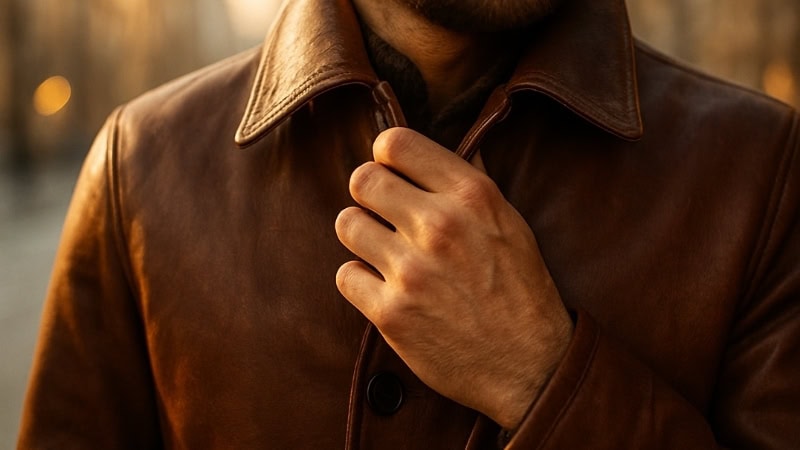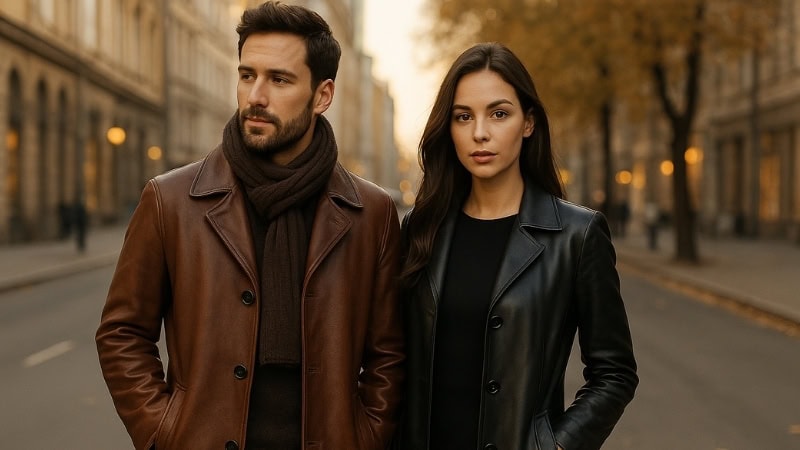A leather overcoat isn’t just a piece of clothing. It’s a statement.
When you throw a leather overcoat over your shoulders, you’re not just protecting yourself from the cold—you’re stepping into a look that oozes confidence, timeless style, and a bit of mystery.
A leather overcoat isn’t just a piece of clothing. It’s a statement. Whether it’s a smooth, jet-black full-grain beauty or a rugged brown piece with stories in every crease.
Today, we’ll break down everything—from picking the right leather to keeping it soft, clean, and ready to turn heads.

Types of Leather Used in Overcoats
Before you buy or maintain a leather overcoat, it’s important to understand what you’re working with. Different leathers have unique textures, durability, and care needs. The wrong type for your climate or lifestyle can mean more repairs, faster wear, and less enjoyment.
The most common types include:
- Full-grain – The king of durability. It shows all the natural markings from the animal’s hide, making each coat one-of-a-kind. It resists wear beautifully and develops a rich patina over time, but it can feel stiffer initially.
- Top-grain – Slightly sanded to remove imperfections, giving it a smooth, uniform look. It’s softer right off the rack and still durable, though it won’t develop as much character as full-grain.
- Split leather – Taken from the lower layers of the hide, often coated for strength. It’s more affordable but less resilient, so expect a shorter lifespan.
- Bonded leather – Made from leather scraps and fibers bonded together with adhesives. Looks the part for a season or two but tends to peel or crack quickly.
Finishes you might encounter:
- Aniline – Soft, natural, and breathable, but prone to stains and water spotting.
- Semi-aniline – Keeps much of the softness but has a thin protective coating for better stain resistance.
- Pigmented – The most durable finish, with a strong coating that makes it easier to clean but less authentic looking.
- Suede/Nubuck – Velvety and luxurious, but requires very careful handling since it stains and scuffs easily.
Recommended Read: PU Leather vs Faux Leather: What’s the Real Difference?
Understanding Leather’s Fragility
It’s easy to think leather is indestructible—after all, it’s used for saddles, boots, and motorcycle gear. But your overcoat isn’t just tough hide; it’s also a refined, finished material that can be surprisingly delicate. Knowing what can harm it is the first step to protecting your investment.
What to watch out for:
- Water – Even light rain can leave spots and strip natural oils, leading to stiffness and cracking.
- Heat – Prolonged exposure to heaters or hairdryers will dry out the fibers faster than you can blink.
- Humidity – A damp environment can invite mold or mildew to settle in.
- Sunlight – Long hours in direct sun can fade the color and weaken the structure.
- Pollution – Urban air contains chemicals that, over time, break down leather finishes and cause discoloration.
Think of leather as skin—it needs moisture, protection, and gentle care to age gracefully.
Top Brands to Trust in and Buy From
Finding the right leather overcoat is about more than just style—it’s about investing in craftsmanship that lasts. Some brands have been in the game for decades, perfecting their tanning techniques, stitch work, and overall fit.
Whether you want a rugged everyday piece or a sleek, high-fashion statement, these brands are the ones to keep on your radar.
- Schott NYC
If there’s one brand that practically defines American leather outerwear, it’s Schott NYC. Known for its robust hides, timeless designs, and impeccable durability, Schott makes overcoats that age like fine wine. Their coats aren’t just clothing—they’re heritage pieces you can hand down. - Belstaff
British to the core, Belstaff blends vintage motorcycling roots with modern tailoring. Their leather overcoats often feature weatherproof finishes and subtle design details that make them stand out without screaming for attention. It’s luxury meets adventure, all stitched into one garment. - AllSaints
If you’re leaning toward urban, minimalist style, AllSaints is a solid pick. Their overcoats often feature buttery-soft leather and slim, modern silhouettes. Perfect for those who want leather sophistication without looking too biker. - Wilsons Leather
A long-standing name in affordable leather, Wilsons delivers both classic and contemporary overcoat styles. They’re a good entry point for anyone wanting real leather without luxury-brand pricing. Great for everyday wear and experimenting with different cuts. - Overland
Overland is where you go if you want a leather overcoat with a softer, more natural touch. They often use lambskin or sheepskin, resulting in lighter and more supple coats. Their pieces have a rustic-meets-refined charm that works for both city walks and countryside getaways.
Recommended Read: Best Way to Clean Leather: The Ultimate Leather Cleaning Guide
Cleaning Leather Overcoats: Step-by-Step
A good cleaning routine keeps your coat looking sharp without damaging the leather. The trick is to keep it light and consistent, avoiding harsh products or over-scrubbing.
Done right, cleaning is less about deep washing and more about maintaining that natural, lived-in look.
Daily to Monthly Maintenance:
- Give it a light dusting with a soft cloth or horsehair brush to remove surface dirt.
- If you spot smudges or fingerprints, wipe them gently with a slightly damp (not wet) microfiber cloth.
Spot Cleaning Techniques:
- For general dirt: Mix a drop of mild soap (like baby shampoo or Woolite) into lukewarm water. Dampen a cloth, wring it out well, and wipe gently.
- For oil or grease: Sprinkle baking soda, cornstarch, or baby powder over the spot. Let it sit overnight to absorb the oils, then brush off.
- For mold or mildew: Mix equal parts rubbing alcohol and water. Dampen a cloth and lightly dab the area—don’t soak the leather.
Avoid:
- Submerging the coat in water.
- Using vinegar, bleach, or household cleaners. These can strip oils, fade color, and weaken the leather fibers.
Conditioning & Hydration
If cleaning is about removing dirt, conditioning is about feeding the leather. Without regular conditioning, leather overcoats lose their suppleness and develop cracks. It’s like moisturizing your skin—you skip it, you feel it.
Why condition:
- Prevents dryness and cracking.
- Keeps the leather flexible and comfortable.
- Restores the rich color and soft sheen.
Frequency: Every 3–6 months, or more often if you live in a dry climate or wear the coat frequently.
How to Store Leather Jackets – Expert Tips
Drying and Storage
One of the biggest mistakes leather owners make is rushing the drying process or storing the coat like any other jacket. Leather needs a little extra thought when it’s wet or put away for the season. The right steps here prevent warped shapes, stiffness, and permanent damage.
If your coat gets wet:
- Shake off excess water.
- Hang it on a wide, padded hanger to preserve shoulder shape.
- Let it air-dry naturally away from direct heat or sunlight.
For storage:
- Keep in a breathable cotton garment bag—not plastic, which traps moisture.
- Store in a cool, dry place with good air circulation.
- Avoid overstuffing the closet so the leather can breathe.
- If vintage, check it monthly for dryness or mold and condition when needed.
When to Call the Pros
Even with the best home care, some jobs are best left to experts. Professionals have the tools, products, and know-how to restore leather without making rookie mistakes. Knowing when to step back can save your coat from costly or irreversible damage.
Call a professional when:
- Your coat has deep cracks, tears, or peeling areas.
- Stains don’t budge after gentle home cleaning.
- The leather smells musty or smoky and airing it out hasn’t helped.
- You want a thorough clean without the risk of over-conditioning or stripping the finish.
Most leather experts recommend a professional clean once a year for heavily worn coats.
Quick Dos & Don’ts
Leather care doesn’t have to be complicated, but there are a few golden rules. Stick to these and you’ll avoid the most common mistakes that ruin good coats. Consider this your “sticky note” version of leather maintenance.
Do:
- Wipe down regularly to remove surface dust and grime.
- Condition twice a year.
- Store on a wide hanger in a breathable garment bag.
Don’t:
- Machine wash or dry clean with regular solvents.
- Dry with heat sources or direct sunlight.
- Over-condition—too much product can make the surface greasy and attract dust.
Quick Care Reference
Leather overcoats can last for decades—but only if you treat them right. This quick care guide gives you the essentials to keep your coat looking sharp year after year.
| Task | Frequency | Tip |
| Dust/Wipe | Weekly | Use a soft cloth; avoid harsh scrubbing |
| Spot Clean | As needed | Mild soap or powder—always blot, never rub |
| Condition | 3-6 months | Apply thinly; buff after absorption |
| Pro Cleaning | Yearly | Especially for vintage or heavily used |
| Storage | Off-season | Padded hanger, cotton cover, cool
dry area |
Why a Leather Overcoat is Always Worth It
Your leather overcoat isn’t just another layer of clothing—it’s a piece of craftsmanship that can stay with you for decades. With the right care, it will soften, age beautifully, and carry a history you can wear with pride.
Respect the leather, be mindful of its needs, and you’ll always have that head-turning, confidence-boosting piece ready for any occasion.



